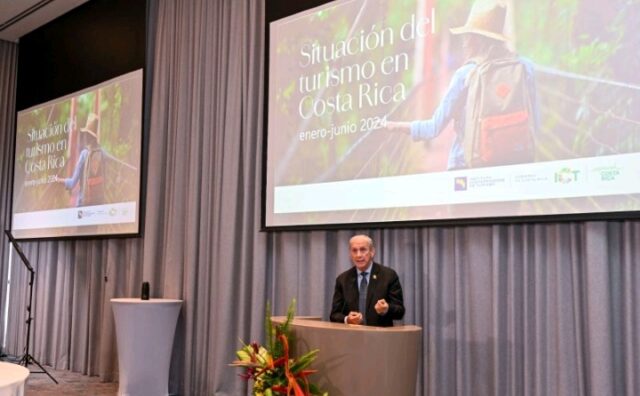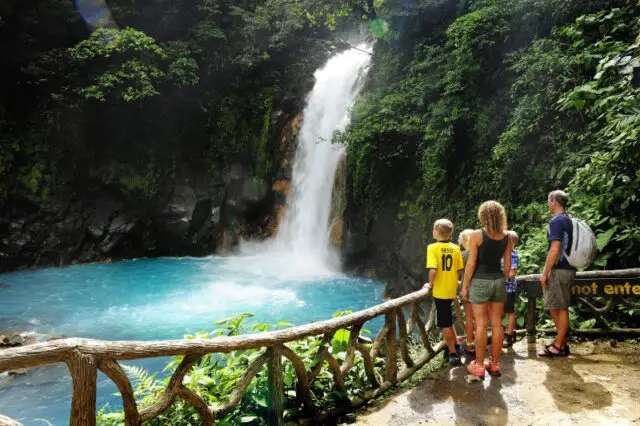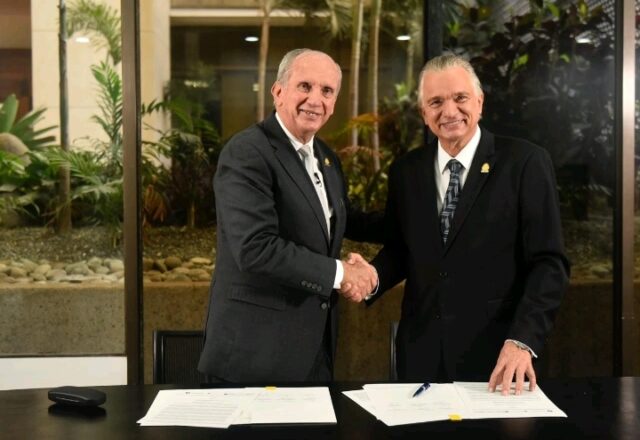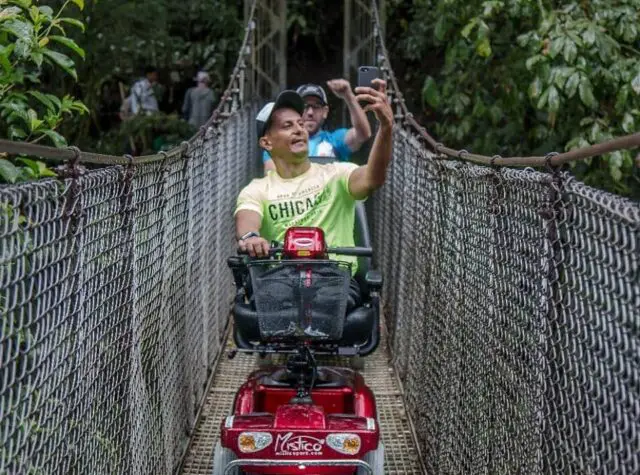A few days ago, I spoke with the Minister of Tourism of Costa Rica, William Rodrı́guez, for our media TCRN, without a doubt, every answer to the questions we asked him is full of valuable information about the actions and purposes focused on Costa Rican citizens, tourists, the current record of visitors, among other topics of interest.
In terms of tourism, there is a lot to say, most of it good news, but initially, the question arose as to what inspires the Minister of Costa Rica, in all senses, be it its people, nature, gastronomy, and everything in general. In his opinion, what inspires him most about the country “is that every destination he visited is wonderful and inhabited by extraordinary people. This makes us an irresistible place for all those who wish to get to know us”.
In this way, Rodriguez defines his country as a unique destination in the world “because it has a combination of factors of nature, biological diversity, diversity of fauna and flora, wonderful people, spectacular cuisine, which make it a unique destination in the world, highly competitive and desirable. The other issue that, for us is undoubtedly a competitive and comparative advantage, is being in the middle of the Americas, with the possibility of attracting a series of market niches, giving us a positioning for MICE tourism, for nautical tourism, among others, that probably few countries have”, he said.
MICE means, in the hotel and tourism environment: Meetings, Incentives, Conferences, and Exhibitions.
Is this the best moment for tourism in Costa Rica?
The Minister emphasized that “it depends on how we see it. To affirm that this is the best moment for tourism in Costa Rica could make invisible key aspects that have been fundamental throughout the country’s tourism history”.
According to the analysis based on international arrivals by air and the foreign exchange income they generate, there is no doubt that Costa Rica is “in an exceptional moment for tourism, with records in both the visitation and income generation”.
In a press conference, Rodríguez informed us that the country had a spectacular first semester, driven by the expansion of routes and the incorporation of new airlines such as GOL from Brazil, as well as the successful promotion of the destination in our main markets.
In addition, he presented figures from January to June of 1,532,443 tourists who have visited Costa Rica by air, which represents an increase of 14.5% compared to the same period in 2023. In fact, they estimate that by the end of 2024, the figure will be 2.8 million tourists by air.
Among the main markets in North America are: United States 947,299 tourists; Canada 163,048 tourists and Mexico 43,356 tourists. From Europe 233,480 tourists, all by air.

What is the capacity of CR to receive tourists?
The number of tourist arrivals by air is in accordance with the National Tourism Plan 2022-2027 (Annex 1, page 147). “Future growth estimates are based on the country’s capacity and on the efforts to be made in different fields (infrastructure, product, planning, development, market, among others)”.
Strengthening of companies
Regarding the number of companies that the Ministry of Tourism expects to be financed with the Program of Guarantees without Portfolio, for Micro and Small Tourism Companies of the Development Banking System, Rodriguez pointed out that the System set maximum amounts in dollars and colones to be placed through the financial operators.
“The Program will be maintained until these amounts are consumed. Now, if we consider that 137 MSMEs were supported in one year, we could estimate that, to allocate the amounts established, we should be reaching around 1,000 MSMEs in total”.
Do you know the Bill “Holidays with Purpose: Personal and Family Wellbeing”?
The Social Affairs Commission of the Legislative Assembly decided in July to file the bill whose file number is 24.274, named “Holidays with Purpose: Personal and Family Welfare”, leaving it without viability.
The project, promoted by congresswoman Pilar Cisneros Gallo, seeks to reform Article 148 of the Labor Code, to allow families to enjoy more time together and encourage domestic tourism, in addition to increasing economic activity in various regions of the country.
The main authority of Costa Rican tourism detailed that there is currently a new Bill in the Tourism Commission, No. 23.981, which intends that, as of 2025, the enjoyment of the holiday corresponding to the dates: April 11, May 1, July 25 and December 1, will be transferred to the immediately preceding Monday, in cases where these dates fall on Tuesday or Wednesday, and to the immediately following Monday when these fall on Thursday.
“From our point of view, bills that tend to favor Costa Ricans to vacation or have recreational trips within the country, is positive and we will support it,” he said.

Tourism focus
The question arose as to where Costa Rica’s tourism is focused, be it adventure, health, entertainment, or geography, among others, and Minister Rodriguez answered that the main reason for visiting the country is for vacations. However, in recent years there has been an upturn and significant interest in meeting tourism, which includes not only corporate travel but also congresses, conventions, corporate events, and incentive travel.
According to information obtained by the Costa Rican Tourism Board (ICT) from different sources, including direct surveys of visitors and information from other industry players such as Mabrian, Expedia, and TripAdvisor, people who choose Costa Rica for vacations are mainly interested in and enjoy products related to adventure, contact with nature (flora, fauna, volcanoes and other natural attractions such as beaches), giving a high rating in terms of satisfaction with their experience.
Given the ICT’s communication efforts, international markets are based on publicizing and promoting the wide range of experiences that “our tourism product offers throughout the country; it does not focus exclusively on the three mentioned above. That range includes wellness activities, our gastronomic product, experiences in communities, cultural aspects, and aquatic activities such as diving, surfing and sport fishing”.
More good news
“Costa Rica has been a pioneer in the protection of its biodiversity, with more than 25% of its territory protected in protected areas and almost as much with some kind of private protection scheme, thus covering almost half of our continental territory, in addition to almost 30% protection of our maritime extension” added the Minister.
The tourism development model is based on three fundamental pillars: sustainability, innovation, and inclusion. In this way, sustainable tourism is promoted through initiatives such as the Certification for Sustainable Tourism (CST), which encourages companies to adopt responsible practices aligned with environmental conservation, while the company is strengthened in economic and financial terms, generating social development for the communities, their inhabitants, their employees and their business partners. “We promote other initiatives such as the Ecological Blue Flag and Tu-Modelo programs.”
Internationally, since January 2024, and for the next four years, Costa Rica has and will have the honor of chairing the Committee on Tourism and Sustainability of UN Tourism. Last June, UN Tourism, the Costa Rican Tourism Institute, and the Ministry of Foreign Affairs of Costa Rica, “signed an agreement to officialize the country as host of the 19th Meeting of the Committee on Tourism and Sustainability, to be held on September 9 and 10 of this year. In addition, in May 2025, Costa Rica will host the ninth edition of the Sustainable & Social Tourism Summit, the first time this important meeting has been held outside of Mexico since its creation eight years ago”.
It is worth mentioning that Costa Rica and Colombia coordinate the CITUR (Inter-American Committee on Tourism of the OAS) committee on Sustainability and Climate Change, and our country also holds a vice-presidency in the OECD tourism committee.
Undoubtedly, these milestones reaffirm that Costa Rica is a global epicenter of sustainable tourism.

Inclusive tourism
In the country, concrete actions have been implemented in key tourist areas where trails, beaches, and activities have been adapted to be accessible to people with disabilities, for example: a canopy tour adapted for wheelchair users, a rainforest suitable for people with disabilities or surfing and catching waves without reduced mobility being an impediment.
Likewise, the Ministry has trained guides and operators in inclusive service and continues to work to make more destinations accessible to all. These actions are implemented in support of the leadership of the Costa Rican Network of Accessible Tourism, thanks to which we currently have the following beaches with some level of accessibility: Junquillal, Panama, Hermosa de Guanacaste, Tamarindo, Puntarenas, Herradura, Jaco, Bandera, Espadilla, Manuel Antonio, Hermosa de Osa, Puita, Cieneguita and Cahuita.
Precisely, the Costa Rican Network of Accessible Tourism was awarded in 2024 as the “Inclusive Organization of the Year” in the first edition of the FITUR 4ALL awards, and in 2021 LonelyPlanet awarded the country as the best accessible destination of the same year.

How does Climate Change affect Costa Rica’s tourism sector?
According to Minister William Rodriguez, Climate Change represents a significant challenge for the tourism sector. Phenomena such as rising sea levels and changes in weather patterns can affect biodiversity and coastal infrastructure, which are essential for tourism. “It is vital that we adopt adaptation and mitigation measures, integrating sustainable practices at all levels of the industry to meet these challenges.
He also stated that the biggest challenge is that the actions being developed to address climate change do not add up to enough to reverse the process, and the phenomenon is no longer frightening. “What the planet is experiencing is a climate emergency and as long as we do not become aware of it and really develop actions and plans to address an emergency, tourism will continue to feel its onslaught with negative effects such as:
a. Delays in routes.
b. Tourist dissatisfaction.
c. Isolation of some destinations.
d. Higher costs for businesses and eventually for tourists.
e. Loss of species due to warming.
f. Affectation of destinations, for example, Monteverde Cloud Forest.
In this issue, we must move from empathy to compassion, being the difference between one and the other, that the second, really makes us take action to address and seek solutions to the problem, while the first is simply to understand what happens without taking any action”.
What are your thoughts on gentrification in Costa Rica?
Gentrification, understood as a process of urban transformation that has historically existed and that can lead to renovation and an increase in property values, has a complex origin and is related to many possible factors such as real estate activity, construction activity, and land values.
For him, tourism is not the trigger for gentrification. On the contrary, the success of the national tourism activity depends on recognizing that the positioning of Costa Rica’s tourism model depends on environmental, commercial, and social practices that promote interactions between subjects (inhabitants and tourists), to create new realities, new senses and meanings that become what we recognize as tourism experiences.
Thus, the target client is a tourist who is respectful of the place he/she visits, who likes to share with the communities in their normal environment, and who values the efforts of society in favor of conservation and respect for the environment and natural resources. “To this target client, harmonious with the model of sustainable tourism development of the country, the strategies of attraction of tourists are directed from the area of Marketing of the ICT”.
Mr. William Rodriguez is a person who, without a doubt, enjoys what he does and loves immensely everything Costa Rica has, therefore he expressed to the Costa Rican citizens: “Feel proud of this beautiful country we have. Although there are always areas for improvement, both nationally and in the tourism sector, we live in a wonderful place. It is the responsibility of each one of us to show it to the world with enthusiasm”. And to the citizens of the world: “Discover us! Make Costa Rica a goal in your life, a must-see destination that you should not miss”.
Dear reader, if you want to know more about Minister William Rodríguez and the advances in the Tourism sector, you can follow his networks and website: On LinkedIn, he appears as William Rodríguez – Minister of Tourism; on Facebook as William Rodríguez – Minister of Tourism and the ICT networks: Instagram @oficial_ict; Facebook Instituto Costarricense de Turismo and the websitewww.ict.go.cr.

